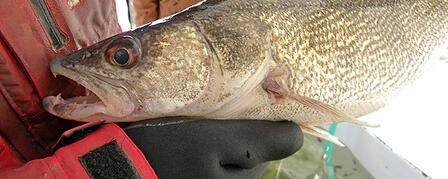ARTIFICIAL WALLEYE SPAWNING A LABOR OF LOVE

March 20, 2014
A female walleye can release as many as 300,000 eggs, but less than 10 percent will survive in nature
PRATT – In late March, a placid lake surface might lead some to believe major fish activity has yet to begin, but for walleye, waves of commotion are occurring beneath the surface as males and females begin spawning. As soon as water temperatures hit 45-50 degrees, walleye begin the annual process, as other fish species do each spring.
Most spawning activity occurs at night when female walleye search for the perfect rocky shoreline to lay their eggs, and male walleyes, who’ve been waiting on the spawning ground for days, fertilize them. With large females producing as many as 300,000 eggs, it’s hard to believe this species would need assistance with the process, but even the best laid plans are no match for Mother Nature. In Kansas lakes, less than 10 percent of naturally-spawned walleye eggs will hatch.
However, hatching success rates can be as high as 70 percent in a hatchery setting. That’s why every year about this time, you’ll see Kansas Department of Wildlife, Parks and Tourism (KDWPT) fisheries biologists working tirelessly at select Kansas lakes. Biologists set nets to capture spawning walleye, then harvest the eggs of ripe females. Once collected, the eggs are then taken to a station where they are fertilized with milt, or sperm, taken from male walleyes caught from the same body of water. After fertilization, the eggs are immediately delivered to the Pratt and Milford fish hatcheries where fish culturists work around the clock to ensure high hatch and survival rates of young walleye, which are then stocked into Kansas lakes as is, or used to produce other hybrid fish species. Last year, KDWPT’s Walleye Culture Program produced 43 million walleye fry (just hatched fish) and 660,000 walleye fingerlings (2-inch fish). With that same batch of eggs, KDWPT staff were also able to produce 7.5 million saugeye fry, 400,000 saugeye fingerlings (walleye/sauger hybrids).
In addition to walleye, KDWPT hatcheries also produce bluegill, channel catfish, crappie, largemouth bass, redear sunfish, sauger, saugeye, smallmouth bass, striped bass, and wipers.
For more information on KDWPT hatcheries and the fish they produce, visit www.ksoutdoors.com and click “Fishing/Hatcheries.”
-30-









